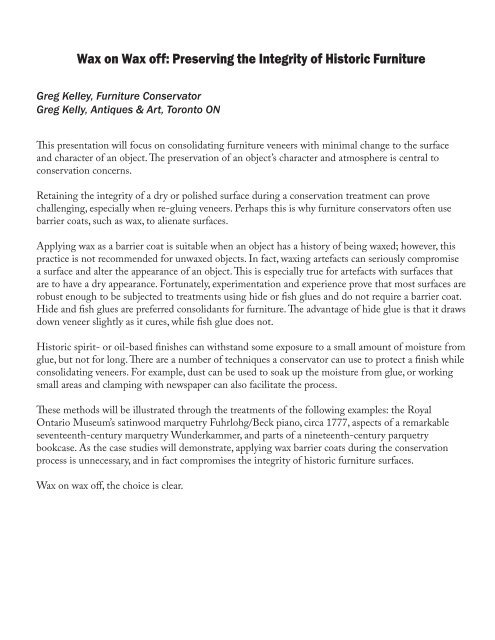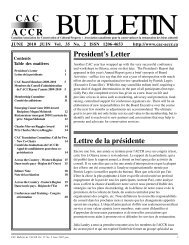Ottawa - Canadian Association for Conservation
Ottawa - Canadian Association for Conservation
Ottawa - Canadian Association for Conservation
Create successful ePaper yourself
Turn your PDF publications into a flip-book with our unique Google optimized e-Paper software.
Wax on Wax off: Preserving the Integrity of Historic Furniture<br />
Greg Kelley, Furniture Conservator<br />
Greg Kelly, Antiques & Art, Toronto ON<br />
Th is presentation will focus on consolidating furniture veneers with minimal change to the surface<br />
and character of an object. The preservation of an object’s character and atmosphere is central to<br />
conservation concerns.<br />
Retaining the integrity of a dry or polished surface during a conservation treatment can prove<br />
challenging, especially when re-gluing veneers. Perhaps this is why furniture conservators often use<br />
barrier coats, such as wax, to alienate surfaces.<br />
Applying wax as a barrier coat is suitable when an object has a history of being waxed; however, this<br />
practice is not recommended <strong>for</strong> unwaxed objects. In fact, waxing artefacts can seriously compromise<br />
a surface and alter the appearance of an object. This is especially true <strong>for</strong> artefacts with surfaces that<br />
are to have a dry appearance. Fortunately, experimentation and experience prove that most surfaces are<br />
robust enough to be subjected to treatments using hide or fish glues and do not require a barrier coat.<br />
Hide and fish glues are preferred consolidants <strong>for</strong> furniture. The advantage of hide glue is that it draws<br />
down veneer slightly as it cures, while fish glue does not.<br />
Historic spirit- or oil-based finishes can withstand some exposure to a small amount of moisture from<br />
glue, but not <strong>for</strong> long. There are a number of techniques a conservator can use to protect a finish while<br />
consolidating veneers. For example, dust can be used to soak up the moisture from glue, or working<br />
small areas and clamping with newspaper can also facilitate the process.<br />
These methods will be illustrated through the treatments of the following examples: the Royal<br />
Ontario Museum’s satinwood marquetry Fuhrlohg/Beck piano, circa 1777, aspects of a remarkable<br />
seventeenth-century marquetry Wunderkammer, and parts of a nineteenth-century parquetry<br />
bookcase. As the case studies will demonstrate, applying wax barrier coats during the conservation<br />
process is unnecessary, and in fact compromises the integrity of historic furniture surfaces.<br />
Wax on wax off, the choice is clear.





